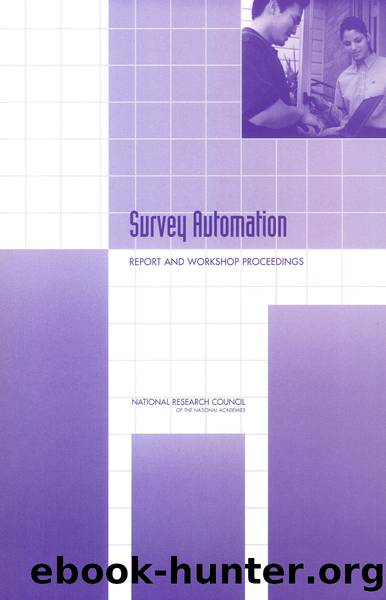Survey Automation : Report and Workshop Proceedings by National Research Council of the National Academies

Author:National Research Council of the National Academies
Language: eng
Format: epub
Tags: Behavioral and Social Sciences. Computers and Information Technology
Publisher: NATIONAL ACADEMY PRESS
Published: 2003-06-11T00:00:00+00:00
Let me just do a little bit more hereâhow am I doing with time?
CORK: The good news is that weâre going to try to copy Tomâs slidesâand everyone elseâsâand have them to distribute tomorrow. The bad news is that I need to ask you to wrap up in about five minutes.
MCCABE: Let me first take questions. Yes?
MARKOSIAN: This question isnât directly relevant to the application, but more of a historical question. [inaudible] And then things got better over time, and now thereâs been remarkable development that seems to be sending things back to the beginning, which was to proliferate current systems. What youâre doing there is introducing two things: the enormous complexity, the syntactical kind of complexity thatâs represented in your chart. And also that complexity is hidden because itâs not available for the programmer to look at, things like leaving to the operating system. So, do you have any approaches to that?
MCCABE: Yeah, there are a lot of them, and some are not pertinent to the subject here. There are a lot of just engineering principles, about testing and project management, that pertain to that. And there are collaboration tools that help with that. So thereâs no silver bullet. But within that I would suggest that, within the newer systems, these issues are even more important because one of the facts of life these days is that you get different contractors and people separated geographically in different countries all working on the same thing. And, [for instance], what Microsoft does, when you recompile every day, the idea is to visualize the thing you have. Easily and frequently, and share that. And itâs probably more important now because of what you say than it was back then. And things are growing in complexity, not the other way around. And the environments are more complex, in fact, and hearing the standards is even more important.
So I thinkâlet me just summarize by saying that youâre saying that we want to know things about data complexity, and thatâs a way to view a subset of data, and then what complexity it induces, and how to test that and how to change that. And a lot of this is about visualization. It was striking to me as we discussed it this morning that the issue, it seems to me about surveys, vis-a-vis documentation and testing, requirements being together up frontâare entirely analogous to what has been happening in software. And in software the joke is that you never get to requirements; the real joke is that the requirements end up being what the source code does. [laughter] And thereâs a certain pathological truth to that, but thatâs the way you end up. And then you re-engineer your way back out. And the other thing that happens all the time in software is that the first thing that goes is documentation. And right with it goes testing. And documentation winds up being what you can get out after the fact, and the testingâunfortunatelyâhas been very ad hoc, at incredible expense.
Download
This site does not store any files on its server. We only index and link to content provided by other sites. Please contact the content providers to delete copyright contents if any and email us, we'll remove relevant links or contents immediately.
Modelling of Convective Heat and Mass Transfer in Rotating Flows by Igor V. Shevchuk(6391)
Weapons of Math Destruction by Cathy O'Neil(6148)
Factfulness: Ten Reasons We're Wrong About the World – and Why Things Are Better Than You Think by Hans Rosling(4694)
Descartes' Error by Antonio Damasio(3230)
A Mind For Numbers: How to Excel at Math and Science (Even If You Flunked Algebra) by Barbara Oakley(3221)
Factfulness_Ten Reasons We're Wrong About the World_and Why Things Are Better Than You Think by Hans Rosling(3199)
TCP IP by Todd Lammle(3134)
Fooled by Randomness: The Hidden Role of Chance in Life and in the Markets by Nassim Nicholas Taleb(3046)
Applied Predictive Modeling by Max Kuhn & Kjell Johnson(3019)
The Tyranny of Metrics by Jerry Z. Muller(3003)
The Book of Numbers by Peter Bentley(2912)
The Great Unknown by Marcus du Sautoy(2648)
Once Upon an Algorithm by Martin Erwig(2599)
Easy Algebra Step-by-Step by Sandra Luna McCune(2585)
Lady Luck by Kristen Ashley(2534)
Practical Guide To Principal Component Methods in R (Multivariate Analysis Book 2) by Alboukadel Kassambara(2497)
Police Exams Prep 2018-2019 by Kaplan Test Prep(2487)
All Things Reconsidered by Bill Thompson III(2357)
Linear Time-Invariant Systems, Behaviors and Modules by Ulrich Oberst & Martin Scheicher & Ingrid Scheicher(2334)
